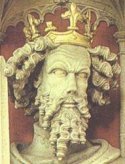Edward was born at the Palace of Westminister on June 17 or 18, 1239. He married twice. His first marriage, to Eleanor of Castile, produced sixteen children, and when Eleanor died in 1290, Edward was heartbroken and displayed his grief by erecting the Eleanor crosses, one at each place her funeral cortege stopped for the night. His second marriage, to Marguerite of France, the daughter of King Philippe III of France, produced a further three children.
Edward's character was in great contrast to that of his father, who had reigned from childhood and was always inclined to favour compromise with his opponents. Edward displayed impatience and considerable military prowess, defeating Simon de Montfort at the Battle of Evesham in 1265 and treating the rebels with great savagery. He pursued the surviving members of the de Montfort family, who were his cousins, relentlessly.
In 1275, pirates in Edward's pay intercepted a ship carrying Eleanor de Montfort, Simon's only daughter, from France, where her family had been in exile, to Wales, where she was to marry Llywelyn the Last, then ruler of the principality. The marriage had been arranged when there was still some political advantage to be obtained from an alliance with Simon de Montfort, but Llywelyn wished to proceed with it largely in order to antagonise his long-standing enemy. Edward seized Eleanor, and imprisoned her at Windsor until Llywelyn conceded his terms for peace in 1278. However, Llywelyn's younger brother, Dafydd, who had briefly been an ally of the English, started another rebellion in 1282. Llywelyn was killed shortly afterwards in a skirmish, and Edward destroyed the remnants of resistance, capturing and executing Dafydd in the following year. To consolidate his conquest, he built a network of stone castles throughout the principality, of which the best known is Caernarfon.
To finance his war to conquer Wales, Edward I taxed the Jewish moneylenders. However, the cost of Edward’s ambitions soon drained the money-lenders dry. Anti-Semitism, a long existing attitude, increased substantially and when the Jews could no longer pay, they were accused of disloyalty. Already restricted to a limited number of occupations, Edward abolished the Jews right to lend money. Like all racism, it evolved until the King decreed that the Jews were a threat to the country and were restricted as to their movements and activities. Edward decreed that all Jews must wear a yellow patch in the shape of a star attached to their outer clothing so that they could be identified in public, an idea Adolf Hitler would adopt 650 years later.
Under King Edward's persecution of the Jews, he arrested all the heads of Jewish households. Over 300 were taken to the tower of London and executed while others were murdered in their homes. Finally in 1290, the King banished all Jews from the country.
Edward then turned his attentions to Scotland, planning to marry off his son to the child queen, Margaret I of Scotland. When Margaret died, he was invited by the Scottish nobles to select her successor from the various claimants to the throne, and he chose John Balliol over Robert Bruce (father of Robert I of Scotland. Opposition sprang up (see Wars of Scottish Independence), and Edward mercilessly executed the focus of discontent, William Wallace, in 1305, having earlier defeated him at the Battle of Falkirk in 1298. His plan to unite the two countries never came to fruition, and he died at the Scottish border while on his way to wage another campaign against the Scots, who were energized by Wallace's martyrdom under the leadership of Robert the Bruce.
Edward died in 1307 at Burgh-on-Sands, Northumberland and was buried
at Westminster Abbey. He was succeeded by his son, King Edward II of England.
| Preceded by:
Henry III |
List of British Monarchs | Succeeded by:
Edward II |
